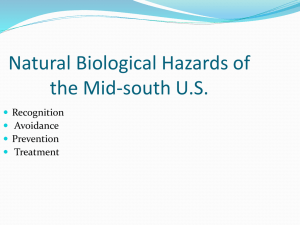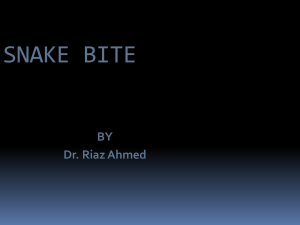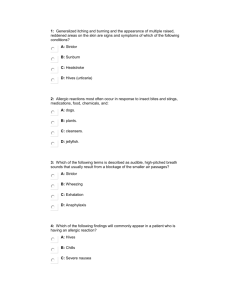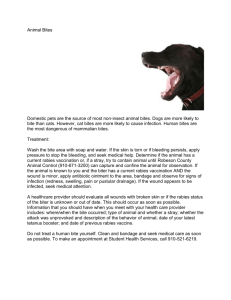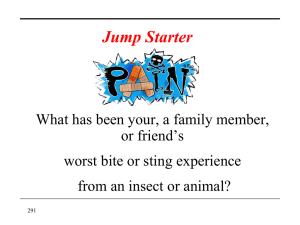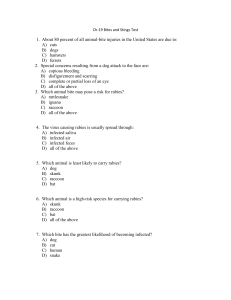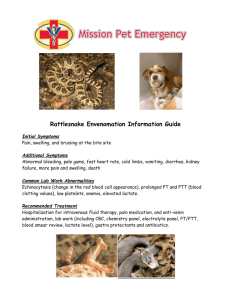V.I.S.S.
advertisement
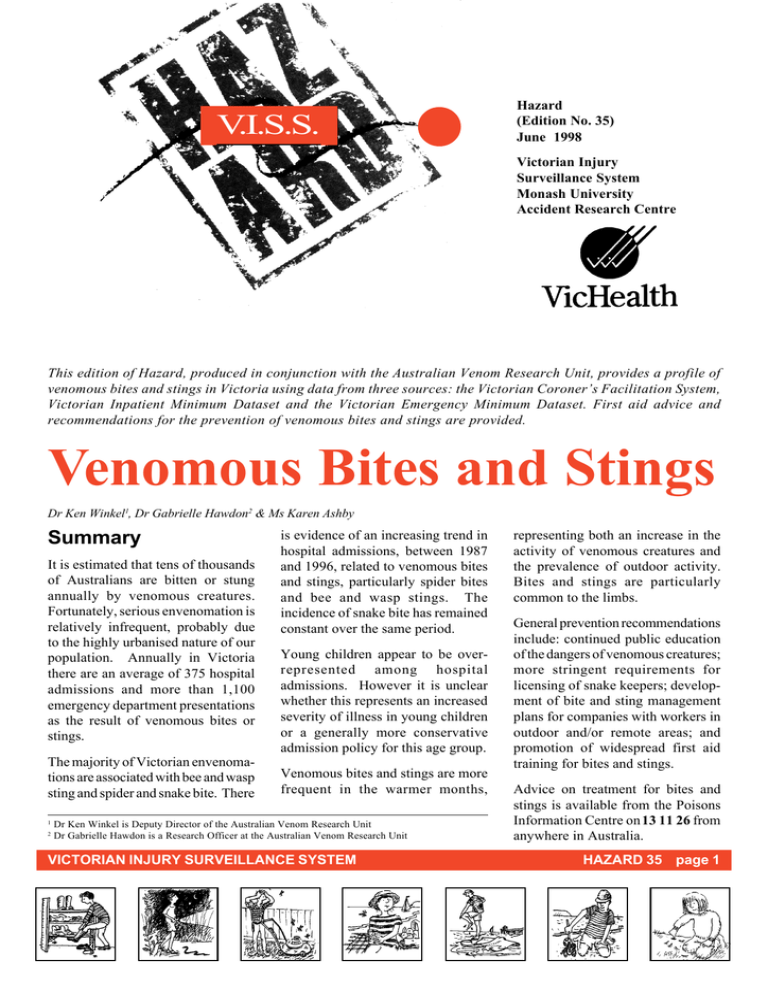
V.I.S.S. Hazard (Edition No. 35) June 1998 Victorian Injury Surveillance System Monash University Accident Research Centre This edition of Hazard, produced in conjunction with the Australian Venom Research Unit, provides a profile of venomous bites and stings in Victoria using data from three sources: the Victorian Coroner’s Facilitation System, Victorian Inpatient Minimum Dataset and the Victorian Emergency Minimum Dataset. First aid advice and recommendations for the prevention of venomous bites and stings are provided. Venomous Bites and Stings Dr Ken Winkel1, Dr Gabrielle Hawdon2 & Ms Karen Ashby Summary It is estimated that tens of thousands of Australians are bitten or stung annually by venomous creatures. Fortunately, serious envenomation is relatively infrequent, probably due to the highly urbanised nature of our population. Annually in Victoria there are an average of 375 hospital admissions and more than 1,100 emergency department presentations as the result of venomous bites or stings. The majority of Victorian envenomations are associated with bee and wasp sting and spider and snake bite. There 1 2 is evidence of an increasing trend in hospital admissions, between 1987 and 1996, related to venomous bites and stings, particularly spider bites and bee and wasp stings. The incidence of snake bite has remained constant over the same period. Young children appear to be overrepresented among hospital admissions. However it is unclear whether this represents an increased severity of illness in young children or a generally more conservative admission policy for this age group. Venomous bites and stings are more frequent in the warmer months, Dr Ken Winkel is Deputy Director of the Australian Venom Research Unit Dr Gabrielle Hawdon is a Research Officer at the Australian Venom Research Unit VICTORIAN INJURY SURVEILLANCE SYSTEM representing both an increase in the activity of venomous creatures and the prevalence of outdoor activity. Bites and stings are particularly common to the limbs. General prevention recommendations include: continued public education of the dangers of venomous creatures; more stringent requirements for licensing of snake keepers; development of bite and sting management plans for companies with workers in outdoor and/or remote areas; and promotion of widespread first aid training for bites and stings. Advice on treatment for bites and stings is available from the Poisons Information Centre on 13 11 26 from anywhere in Australia. HAZARD 35 page 1 Introduction Despite Australian venomous creatures being amongst the most deadly in the world, serious envenomation in Australia is relatively infrequent, probably due to the highly urbanised nature of our population. In addition, advances in medical care and the development of specific antivenoms for most of Australia’s highly venomous creatures have significantly reduced the morbidity and case fatality rate of envenomation. Nonetheless, fatalities continue to occur. Many envenomations are without specific therapy and it is estimated that tens of thousands of people are bitten and stung annually. Improved outcomes (reduced mortality and morbidity) depend upon adequate understanding of the current burden and patterns of envenomation injury as they relate to toxin pharmacology. In the past, estimates of envenomation were largely based on survey data. With the advent of computerised databases in hospitals the recording of patient data for costing and accounting purposes has opened the way for scientific data collection. In this edition of Hazard these data are utilised to analyse inpatient and emergency department venomous bite and sting injury data. The main databases utilised for this purpose are the Victorian Coroner’s Facilitation System, Victorian Inpatient Minimum Dataset (VIMD) and the Victorian Emergency Minimum Dataset (VEMD)3. Envenomation represents 0.8% of VEMD and 0.7% 3 of VIMD injury cases. Limitations and strengths of these datasets are outlined in the box on page 12. Injury presentations to general practitioners, as well as those patients bitten or stung who do not present for treatment, are not represented. Deaths From July 1989 to June 1994, an average of one death per year in Victoria has been attributed to bites or stings by venomous creatures (Table 1). This is probably an underestimate due to cases where the cause of death is uncertain. Of the five recorded fatalities, three were attributed to allergic reactions to bee stings whilst the other two related to snake bite (Table 2). Whether any of the apparent bee sting deaths were actually due to other insects such as the increasingly common European wasp (Vespula germanica) is not clearly determined (Levick, Winkel and Smith, 1997). In its native Europe, Vespula germanica is responsible for more deaths than the honey bee (Apis mellifera) (Mosbech, 1983). Unfortunately, in contrast to snake bite, there is no diagnostic test available to distinguish between bee and wasp stings at post mortem. The database does not record whether these “bee” victims had a prior history of severe allergic reactions to bee stings. This information may be useful in assessing preventability as immunotherapy and self injectable adrenaline are available to reduce the risk for persons with serious bee and wasp allergies. Future Coroner’s investigation protocols should collect this information. Previous studies of snakebite fatalities emphasise the importance of early application of pressure-immobilisation first aid (see first aid section, p8). Despite such recommendations, Sutherland and Leonard (1995) reported that none of the 12 snake bite related deaths occurring nationally during the three year period 1992-1994 had received appropriate Bite and Sting Morbidity and Mortality – Victoria Mean annual frequency Deaths Hospitalisations Emergency Department Presentations (VEMD) Table 1 Male: female ratio 1 4:1 375 2.1:1 1104 1.3:1 Source: Coroners Facilitation System, July 1989 to June 1994; VIMD, July 1987 to June 1996 and VEMD October 1995 to December 1997 VEMD collection, from October 1995: Austin and Repatriation Medical Centre, Ballarat Base Hospital, The Bendigo Hospital, Box Hill Hospital, Echuca Base Hospital, The Geelong Hospital, Goulburn Valley Base Hospital, Maroondah Hospital, Mildura Base Hospital, Mildura Base Hospital, The Northern Hospital (formerly PANCH), Royal Children’s Hospital, St Vincent’s Public Hospital, Wangaratta Base Hospital, Warrnambool and District Base Hospital, Western Hospital, The Williamstown Hospital and Wimmera Base Hospital. From November 1995: Dandenong Hospital. From December 1995: Royal Victorian Eye and Ear Hospital and Frankston Hospital (formerly Mornington Peninsula Hospital). From January 1996: Latrobe Regional Hospital. From July 1996: The Alfred Hospital and Monash Medical Centre. From September 1996: The Angliss Hospital. From January 1997: Royal Melbourne Hospital. VICTORIAN INJURY SURVEILLANCE SYSTEM HAZARD 35 page 2 Venomous bites and stings in Victoria Table 2 Emergency Department presentations (N = 2617) % Hospital admissions Unnatural deaths (N = 3378) % (N = 5) % Hornets, wasps and bees 41 33 60 Spiders 46 30 - Snakes 9 22 40 Marine animals and plants 1.8 1 - Scorpions 0.4 0.3 - Centipede and millipede 0.2 0.2 - Other specified 1.4 8.5 - Unspecified/missing 0.1 5 - Total 100 100 100 Injury Cause Adult (15+ yrs) Table 3 Child (<15 yrs) Total N % N % N % Hornets, wasps and bees 774 31 340 37 1114 33 Spiders 806 33 200 22 1006 30 Snakes 535 22 223 24.5 758 22 Marine animals and plants 35 1 6 0.7 41 1 Scorpions 11 1 0 0 11 0.3 Centipede and millipede 3 0 3 0.3 6 0.2 Other specified 182 7 94 10 276 8.5 Unspecified/ missing 118 5 48 5.5 166 5 Total 2464 100 914 100 3378 100 It is notable that whilst spider bite is the cause of considerable morbidity, it is not among the causes of fatality in Victoria (Table 2). The Box Jellyfish (Chironex fleckeri) is Table 3 displays the number and proportion of hospital admissions coded as venomous bites and stings involving children (under 15 years) and adults (15 years and above) from July 1987 to June 1996. Of those cases in which the category of venomous creature is identified, “spiders” predominate for adults, followed by “hornets, wasps and bees” compared with children where “hornets, wasps and bees” were the largest category, followed by “snakes and lizards”. The differences in proportion between adults and children are minor, making bites and stings from these three groups of creatures are an important focus for injury prevention measures. Bite and sting hospitalisations by age and sex Source: VIMD, July 1987 to June 1996 first aid. Better and continuing public education is necessary to address this problem. The Victorian Minimum Inpatient Dataset (VIMD) recorded an average of 375 venomous bite and sting related admissions per year to Victorian public and private hospitals from July 1987 to June 1996, with a male to female ratio of 2.1 to 1 (Table 1). Hospital admissions include serious cases, or those cases in which admission is felt to be desirable for reasons such as distance from home, the age or frailty of the patient, or other potential complications. Major causes of bite and sting hospitalisations Source: Coroners Facilitation System, July 1989 to June 1994; VIMD, July 1987 to June 1996 and VEMD October 1995 to December 1997 Major causes of bite and sting hospitalisations Hospitalisations Australia’s most venomous marine creature and has been responsible for at least 61 deaths in tropical Australia since 1884 (Williamson et al, 1996). Since it is not found in temperate waters, venomous marine bite and sting related fatalities are rare in Victoria. VICTORIAN INJURY SURVEILLANCE SYSTEM Figure 1 presents Victorian hospital venomous bite and sting injury admission rates (per 100,000) by age and sex for 1995/96. Note that males predominate in these admissions for most age groups. The proportion of males to females in the population is approximately equal except in the older age groups, females begin to predominate over the age of 75. Thus HAZARD 35 page 3 Bite and sting hospitalisation rate by age and sex for 1995/96 Figure 1 25 Rate per 100,000 20 Male Female 15 10 5 0 0-4 5-9 10-14 15-19 20-24 25-29 30-34 35-39 40-44 45-49 50-54 55-59 60-64 65-69 70-74 75-79 80-84 85+ Age in years Source: VIMD, July 1995 to June 1996 Trends in all age bite and sting hospitalisations Figure 2 12 Rate per 100,000 10 8 Hospitalisation Rate (total) 6 Poisson Regression Trend Line 4 slope = 1.04, 95%CI (1.02, 1.05), p-value <0.001 2 0 1987/88 1988/89 1989/90 1990/91 1991/92 1992/93 1993/94 1994/95 1995/96 Year Source: VIMD, July 1987 to June 1996 the over-representation of males in these injuries is a real phenomenon, and may be related to occupational exposure (more outdoor and rural occupations) as well as to greater risk-taking behaviour in males (for example catching and keeping snakes). This trend is also observed in emergency department presenta- tions (Figure 3). The over-representation of males amongst beekeepers combined with the frequency of bee stings may also contribute to this trend. When adjusted for population distribution (Figure 1), it appears that young children are over-represented amongst hospital admissions. It is VICTORIAN INJURY SURVEILLANCE SYSTEM unclear whether this represents: increased severity of illness amongst young children (possibly as a result of their lower body weight and therefore relatively higher dose of venom); a generally more conservative admission policy for children; or an increased incidence in children. It is particularly important for parents and children to be warned about the dangers of venomous creatures and to be aware of appropriate first aid for bite and sting injuries (see Prevention box, p10&11). Venomous bite and sting related hospitalisations appear to be increasing. Figure 2 shows the trend in such hospitalisations over the last decade. Most of the 30% increase over this period is due to spider bites and bee and wasp stings rather than snake bite, which has remained fairly constant. Further research is required to understand the basis of this significant trend. However it is clear that the European wasp is increasing in numbers and distribution (Levick, Winkel and Smith, 1997). Such injury determinants should be targeted for priority interventions. Fortunately most envenomation hospitalisations are relatively brief (1-2 day duration per admission). An important unanswered question, from this data, is how many of these admissions were related to skin ulceration due to spider bite (termed necrotising arachnidism). Little information is available on the patterns of morbidity due to this condition. Emergency Department Presentations The Victorian Emergency Minimum Dataset (VEMD) recorded an average of 1104 emergency department presentations per year for bites or HAZARD 35 page 4 Major causes of bite and sting emergency department presentations Injury Cause Adult (15+ yrs) Table 4 Child (<15 yrs) Table 4 contains emergency department presentation data from the period October 1995 to December 1997. This table illustrates the difference between the proportions of venomous creatures associated with admissions and those associated with emergency department presentations. In terms of presentations, spider bite represents the largest group of adult presentations at 49%, while spider bite and bee stings are equally dominant amongst paediatric presentations, at 38% and 39% respectively. Little difference appears to exist between the proportions of other causes of adult and child presentations. Total N % N % N % Spiders 895 49 298 38 1193 46 Bees 492 27 301 39 793 30 Wasps 200 11 73 9 273 11 Snakes 175 9 68 9 243 9 Ant 22 1 15 2 37 1 Jellyfish 21 1 11 1 32 1 Stingray 15 0.8 2 0.3 17 0.7 Scorpions 8 0.4 3 0.4 11 0.4 Tick 7 0.4 3 0.4 10 0.4 Centipede 2 0.1 1 0.1 3 0.1 Catfish 2 0.1 0 0 2 0.1 Millipede 1 0.1 0 0 1 0.1 Other anaphylactic reaction 1 0.1 1 0.1 2 0.1 1841 100 776 100 2617 100 Total Source: VEMD, October 1995 to December 1997 Bite and sting emergency department presentations by age and sex, Victoria Figure 3 200 180 160 140 Male Female Frequency 120 Major causes of bite and sting emergency department presentations 100 Note that in this analysis, the categories of “bees” and “wasps” are separated, and a category for “ants” is also available. Similarly, marine envenomation is divided into separate categories for stingrays, catfish and jellyfish. Very few Victorian emergency department presentations relate to the causes outside the top four however. Prevention recommendations will concentrate on these more frequent causes of bites and stings (see Prevention box, p10 & 11). 80 Seasonality of envenomation 60 Bite and sting related hospitalisations and emergency department presentations display marked seasonality, with both presentations and admissions being significantly more frequent in the warmer months (Figure 4). This probably represents not only increased numbers and activity of venomous creatures during this period, but also increased outdoor activity of the at-risk population. Efforts directed towards prevention and education may be particularly 40 20 0 0-4 5-9 10-14 15-19 20-24 25-29 30-34 35-39 40-44 45-49 50-54 55-59 60-64 65-69 70-74 75-79 80+ Age in years Source: VEMD, October 1995 to December 1997 stings from venomous creatures in Victoria over the period October 1995 to December 1997, with an overall male to female ratio of 1.3 to 1.0 (Table 1). VICTORIAN INJURY SURVEILLANCE SYSTEM HAZARD 35 page 5 Bites and stings by month of presentation, Figure 4 Victoria Hospitalisations (N = 3378) and emergency department presentations (N = 2422) 20.0 18.0 16.0 VIMD VEMD 14.0 % of total 12.0 10.0 8.0 6.0 4.0 2.0 0.0 J F M A M J J A S O N D Month Source: VIMD July 1987 to June 1996, VEMD January 1996 to December 1997 Location of all-age bite and sting injuries – emergency department presentations Location Frequency Home Table 5 % of total 1523 58 131 5 Farm 67 3 Road, street or highway 63 2 Trade or service area 57 2 School or day care centre 46 2 Other specified location 167 6 Unspecified location 563 22 2617 100 Place for recreation Total Source : VEMD, October 1995 to December1997 timely during the lead-up to this period. Poisons Information Centre Spider bite, mostly unidentified spider, was the most common poison exposure precipitating calls to the Poisons Information Centre in 1997 (1,335 calls), well ahead of paracetamol and cough and cold pre- parations. The white tailed spider was the single largest category of identified spider bite calls (209 calls). Wasp stings were in the top ten for 1996 but failed to appear on the list for 1997 (366 wasp sting calls for 1997). VICTORIAN INJURY SURVEILLANCE SYSTEM Discussion Table 2 shows the bites and stings presenting to Victorian hospitals categorised by the type of venomous creature involved. Most of the emergency department presentations related to “spiders” and “hornets, wasps and bees”. These categories combined account for 87% of recorded emergency department bite and sting injury presentations. Note that the injury classifications were designed for North America. Australia, for example, is not home to any species of true hornets. Further, the VEMD mostly fails to distinguish between various bite and sting injuries such as between the types of spider and snake bites. The important venomous snakes in Victoria will be discussed on page 8 (see “Dangerous Victorian Snakes”). Table 2 also demonstrates that “spiders”, “hornets, wasps and bees” and “snakes and lizards” are the major causes of bite and sting admissions to Victorian hospitals. The generally more severe consequences of snakebite lead to their over-representation amongst admissions (40% of emergency department presentations resulted in admission). The much larger numbers of bee and wasp stings explain their importance, even though proportionately fewer required admission (4% bees, 1% wasps) compared with snake bite. Of spider bites presenting, 5% were admitted. The only venomous lizards in the world are found in North America (the Gila Monster and the Beaded lizard). However our larger native lizards can pose a hazard through their bite which can produce significant wounds with difficult to treat infections. HAZARD 35 page 6 The most significant spider bite in Victoria is that of the Redback spider. Most often, however medical treatment is not required. See the first aid section (p8 & 9) for discussion of the various spider bites in Victoria. (James, personal communication). Such a hobby makes snake bite almost inevitable (Pearn, Covacevich, Charles and Richardson, 1994) – a VEMD snake bite text example “snake keeper who has 95 snakes at home”. Location Wasps and spiders particularly like living in and around homes. VEMD text examples illustrate typical situations “wasp bite, stung on arm while hanging out washing” and “bitten on ankle by European wasp whilst watering garden at home”. Occasionally the injury is not due to the bite itself – “riding off road motorbike, swerved to avoid snake and hit rock”. Other text examples show the danger in handling venomous creatures even when dead, such as “kicked a dead stingray – sting went into toe”. As with other injuries (see Hazard 32 – Safe Home Design) most bite and sting injuries presenting to Victorian Emergency Departments (58%) are reported as having occurred in the home (Table 5). Analysis of inpatient data (VIMD) reveals that most bite and sting hospitalisations occur in non-metropolitan regions of Victoria (73%). While this emphasises the greater risk of these injuries in rural communities and the need for prevention strategies to target non-metropolitan Victoria these data could also reflect the different admission policies in rural hospitals. It might be expected that snakebite would occur more frequently in rural areas, although Victoria’s most dangerous snake (the Brown snake Pseudonaja textilis) can be found in metropolitan areas. Spider bite and bee and wasp stings are all, theoretically, as likely to occur in an urban environment as in the country, and these types of envenomations comprise most bites and stings. Bite and sting prevention should therefore concentrate on the risky situations and behaviours at home as much as, if not more than, the obvious behaviours such as bushwalking. VEMD text examples reinforce prevalence of bites and stings occurring at home – “cleaning woodheap when bitten by snake” or “bitten on leg by spider at home whilst watering garden ”. Hundreds of people in Victoria keep and breed venomous snakes at home Activity VEMD data indicates that persons were mostly undertaking leisure activities (52%) or working for income (5.5%) when the bite or sting occurred. As with the location variable there were a large number of cases for which the activity was “not specified” (22%) or “other specified activity” (4.3%) thus potentially undermining the representativeness of these data. Further narrative analysis was undertaken of bee and wasp stings and spider bites recorded on the original VISS database. This database collected detailed surveillance data from clusters of Victorian public hospitals from 1988 to 1996. and stings from spiders, bees and wasps respectively, eg. “mowing disturbed a wasps’ nest, bitten by wasps”; “helping in the garden, bitten on finger by Redback Spider”. Bites and stings during transportation were also common to all three (4, 6 and 9% respectively) eg. “passenger in car, bee flew through window, stung by bee”; “riding a motorcycle to work, bee came into helmet and stung patient in the eye”. Of the remainder, 18% of bee and 3% of wasp stings occurred when persons trod on, or near, a bee or wasp eg. “while playing barefoot in yard with brother, child stood on a bee”; 8% of wasp and 6% of bee stings occurred when the person disturbed a nest; and 7% of spider bites and 6% of wasp stings occurred when the person was dressing, eg. “putting on old shoe to play outside, Redback spider in shoe, bit child’s big toe”. Bite site Not surprisingly most bites and stings resulting in emergency department presentation occur on the upper (36%) and lower (29%) limbs (Figure 5). The hands and fingers (23% of total bites and sting ED presentations) and feet and toes (16%) were the body parts most often affected. Appropriate attire will reduce the risk of bite and sting injury (see specific prevention recommendations, p10 & 11). Certain activities were commonly associated with bites and stings from spiders, bees and wasps. Gardening activities (including planting, weeding, mowing and digging) were associated with 7, 5, and 10% of bites VICTORIAN INJURY SURVEILLANCE SYSTEM HAZARD 35 page 7 Figure 5 Head and face 11% Other 1% Upper limb 36% and venomous. Identification of tiger snakes by the presence of stripes is unreliable. Indeed some tiger snakes are unstriped and black. Features of tiger snake envenomation include neurotoxicity, coagulopathy and muscle destruction. It is potentially deadly. Black snakes (Genus Pseudechis) Trunk 3% Unspecified body region 20% Lower limb 29% • Amongst this genus only the red-bellied black snake (P. porphyriacus) is native to Victoria. While still dangerous, this snake is somewhat less venomous than many other Australian snakes. Its bite may cause coagulopathy, neurotoxicity and muscle destruction, but no deaths have been confirmed. Its range covers eastern Australia, but not Tasmania. Copperhead (Austrelaps superbus) Source: VEMD, October 1995 to December 1997 Dangerous Victorian snakes Common or Eastern Brown snake (Pseudonaja textilis) • The genus Pseudonaja, which also contains the dugite (P.affinis) and the gwardar (P.nuchalis), is found throughout Australia, and is responsible for the majority of snakebite deaths in this country. Blood clotting disturbance is common after brown snake bites. Neurological symptoms may also occur. • This snake is limited to Victoria, Tasmania and the western plains of New South Wales. It is a copious producer of venom which has neurotoxic, coagulopathic and myolytic activity, but rarely causes fatalities. Sea snake bites, although theoretically possible in Victoria, are rare. Most sea snakes live in tropical rather than temperate waters. First Aid Treatment Snakes - even though not all snakes are venomous, it is best, from a first aid point of view, to consider all snakes as dangerous. Sometimes only small amounts or no venom is injected, even if puncture marks are present. Tiger snake (Notechis scutatus) • Tiger snakes are found in the temperate areas of southern Australia, including Tasmania, where they are particularly large Snake venom is injected quite deeply. It was shown many years ago that little venom is removed by incision or excision and this is not a recommended practice. Research has VICTORIAN INJURY SURVEILLANCE SYSTEM shown that very little venom reaches the blood stream if pressure is applied over the bitten area and the limb is immobilised (Sutherland et al, 1979; Sutherland, et al 1981). The six step pressure/immobilisation procedure is outlined below. This procedure is recommended for snake bites, including sea snakes and the majority of other serious bites and stings (some exceptions are listed below). Arterial tourniquets are no longer recommended for any type of bite or sting (Sutherland and Duncan, 1980; Sutherland, 1983). Redback spiders – no first aid is recommended for these bites other than the local application of iced water. The venom works very slowly and if its movement is restricted pain can become very severe. An antivenom is available to treat this bite. Other types of spiders – a variety of common house and garden spiders frequently deliver bites causing transient localised pain and swelling. Bites are best lightly washed with water and iced water may give relief from mild pain or itching. Medical advice should be sought if local changes are causing concern. Uncommonly the bite site can ulcerate and cause chronic skin problems. The white tailed spider is one of several spiders implicated in this process. There is no antivenom available to treat this problem. If bitten by a spider try to preserve the spider for identification purposes. Some species of Funnel-web spiders exist in Victoria. None of these is known to be as dangerous as the more northerly Funnel-web spiders such as the Sydney Funnel-web spider. However all Funnel-webs should be treated as potentially dangerous and HAZARD 35 page 8 Pressure/immobilisation procedure: 1. Apply a broad pressure bandage over the bite site as soon as is possible (do not take off clothes as the movement in doing so will assist venom to enter the blood stream. Keep the bitten leg still!). 2. The bandage should be as tight as you would apply to a sprained ankle. Note: Bandage upward from the lower portion of the bitten limb. Even though a little venom is squeezed upwards the bandage will be far more comfortable. 3. Extend the bandage as high as possible. Recent research stresses the importance of keeping the patient still, including the non-bitten limbs. (Howarth et al 1994). Bring the transport to the patient. The first aid measures can always be quickly reapplied if deterioration occurs and left on until urgent additional antivenom therapy has been effective. 4. Apply a splint to the limb. 5. Bind it firmly to as much of the limb as possible. 6. For bites on hand and forearm a) bind to elbow with bandages b) use splint to elbow c) use sling If bitten on the trunk apply firm pressure over the bitten area if possible, do not restrict chest movement. There is no first aid for bites to the head or neck. the pressure-immobilisation type of first aid used. An antivenom is available. Bees, wasps and ants – anaphylactic death can occur in allergic persons. Toxicity due to the injected venom is less common. Since multiple stings are dangerous, particularly in children, those with more than ten stings should seek medical attention (Levick and Braitberg, 1996). In nonallergic persons iced water usually relieves the bite site pain. In all cases bee stings should be scraped off or pulled off as quickly as possible. If the person is known to be allergic the pressure/immobilisation procedure should be used and medical care sought immediately. Patients who suffer severe reactions should always VICTORIAN INJURY SURVEILLANCE SYSTEM have access to injectable adrenaline and know how to use it (Glaspole et al, 1997). The Australian paralysis tick – The tick should be removed as soon as possible. The tick should be levered out using a pair of curved scissors. If the patient is already ill the pressure/ immobilisation procedure should be used if possible to inhibit the movement of any toxic saliva which has been expressed during the removal of the tick. If one tick is found others should be sought as a precaution. An antitoxin is available. Blue-ringed octopus – the pressure/ immobilisation procedure is recommended. Prolonged artificial respiration may be required following a blue-ringed octopus bite. Whilst this octopus is common around Victoria no antivenom is available. Jellyfish – Most jellyfish in Victoria waters produce only minor local reactions which are best treated with ice water packs and simple analgesics. For stings in more tropical waters pour domestic vinegar over the adhering tentacles to inactivate them as soon as possible (Hartwick et al 1980). This is most important for the Box Jellyfish stings. Cardiopulmonary resuscitation (CPR) may be required for these stings. In severe cases the pressure/immobilisation procedure should be applied to the affected limb after the application of vinegar. Whilst a Box Jellyfish antivenom is available there are no other jellyfish antivenoms. Stings from Physalia (the‘Blue Bottle” or ‘Portuguese man ‘O’ war’) jellyfish are best washed with sea water and then covered with ice water packs (Exton et al 1989). HAZARD 35 page 9 General prevention recommendations • Where possible, the creature responsible for the bite or sting should be identified and described to treating doctors but do not attempt to catch snakes responsible for bites. • The requirements for a licence to keep venomous Australian snakes should include current first aid training. It is recommended that such licences should accurately document the number and type of snakes kept and that this requirement be strictly enforced and updated. • Further it should be a requirement of such licences that the local hospital be notified of what venomous snakes are kept by snake fanciers or animal parks/zoos in their area. Management plans and protocols should be formulated in case of snake bite, particularly by non-native snakes where the provision of antivenoms urgently may prove difficult. This is also true of organisations holding other venomous creatures, especially those exotic to the locality. • Companies with employees in remote or rural locations should develop a management plan in case of envenomation, suitable to their industry, locality and the activities undertaken by their workers. Plans could include items such as: up to date first aid procedures; wearing of protective clothing; and procedures for maintaining routine radio contact for workers in remote locations. The plans should be regularly reviewed and expert assistance sought in their drafting. This may prove lifesaving in the case of rapidly life-threatening bites and stings. • Companies with employees working outdoors should create protocols to prevent bite and stings and document and train personnel in first aid procedures in case of such injuries. • First aid training for bites and stings should form part of the school curriculum. This should include basic life support techniques, especially for staff. • Local, State and Federal government should support and fund a coordinated strategy to reduce the health impact of venomous bites and stings. The European wasp is a particular priority. This should include ongoing injury surveillance, dissemination of information to the community on living with wasp problems, subsidies for the destruction of wasp nests and funding for nationwide wasp population control. • Future revisions of the ICD-10 coding manual should differentiate between species of venomous creatures. • Emergency Departments collecting surveillance data should attempt to record more specific details of the determinants of the injury such as - “put hand in glove whilst using chainsaw, bitten by Redback spider” or “child bitten by white tailed spider, found playing with it” rather than simply “bitten by spider”. Specific prevention recommendations: Snake bite: • • • • • • • • • • • Leave snakes alone. If a snake is seen, walk away quietly, do not attempt to kill it. Wear stout shoes and adequate clothing in “snake country”. Never put hands in hollow logs or thick grass without prior inspection. When stepping over logs, carefully inspect the ground on the other side. Always use a torch around camps and farmhouses at night – most snakes are active on summer nights. Keep sheds and fodder storage areas free of mice and rats; they will attract snakes. Keep grass well cut. Never let children collect venomous snakes. If a young child says he or she has come in contact with a snake, believe them. When possible carry a radio transmitter when travelling far from civilisation. Be aware of current first aid methods to treat snake bite (especially if keeping venomous snakes!). Spider bite: • Always garden wearing gloves. • Do not leave clothes lying on the floor as this will provide a refuge for spiders. • Shake out and inspect clothes, gloves or shoes before wearing, particularly if these items have been placed outside for any amount of time. • Inspect outdoor furniture before sitting on or carrying. • If Redback spiders are found - always check for more as one egg sac from one female can give rise to more than 300 young. • Avoid clutter as it attracts spiders that feed on other spiders or insects. VICTORIAN INJURY SURVEILLANCE SYSTEM HAZARD 35 page 10 Specific prevention recommendations (cont.) Bee and Wasp Stings: (adapted from ‘Living with European wasps’, Victorian Department of Natural Resources and the Environment) • Beware clovered lawns as bees are particularly attracted to this pollen. • Try to avoid wearing perfumes, cosmetics and bright clothes, particularly on sunny days when bees and wasps are most active. • As a precaution shoes should be worn around garden lawns, particularly when watering. • Do not disturb wasp nests or bee hives unless fully prepared and never approach them during daylight hours as this is when they are most active. • Sweet beverages attract these insects - use glasses or straws rather than drinking from cans or bottles whilst outdoors. • Before consuming food outdoors check for wasps. Wasps like to hide inside and underneath food -particularly meat, fish and confectionery. • Do not swat at or annoy wasps that are hovering around food - wasps are attracted to moving targets. • Warn children of the dangers of wasps and bees - particularly about the dangers of approaching nests. • Have wasp nests destroyed if found. References • Exton DR, Fenner PJ, Williamson JA. • • • • • • • • (1989) Cold packs: Effective topical analgesia in the treatment of painful stings by Physalia and other Jellyfish. Med J Aust 151:625-6. Glaspole I, Douglass J, Czarny D, O’Hehir R. (1997) Stinging insect allergies. Assessing and managing. Aust Fam Physician 26:1395-1399. Hartwick R, Callanan V, Williamson J. (1980) Disarming the box jellyfish. Nematocyst inhibition in Chironex fleckeri. Med J Aust 1:15-20. Hawdon G, Winkel KD. (1997) Venomous marine creatures. Aust Fam Physician 26:1369-1374. Howarth DM, Southee AE, Whyte IM. (1994) Lymphatic flow rates and first aid in simulated peripheral snake or spider envenomation. Med J Aust 161:695-700 James, W. 1998, Wildlife Licensing Branch, Victorian Department of Natural Resources and the Environment, personal communication. Levick NR and Braitberg G. (1996) Massive European wasp envenomation of a child. Emerg Med 8:239-245. Levick NR, Winkel K, and Smith G. (1997) European wasps: an emerging hazard in Australia. Med J Aust 167:650651. Mosbech H. (1983) Deaths caused by wasp and bee stings in Denmark 19601980. Allergy 38:195-200. Acknowledgements • Pearn JH, Covacevich J, Charles N, Richardson P. (1994) Snakebite in herpetologists. Med J Aust 161:706-708. • Sutherland SK. (1983) ‘Australian Animal Toxins’, Oxford University Press, Melbourne. • Sutherland SK, Coulter AR, Harris RD. (1979) The rationalisation of first aid measures for elapid snake bite. Lancet 1:183-6. • Sutherland SK, Coulter AR, Harris RD, Lovering KB, Roberts ED. (1981) A study of the major Australian snake venoms in the monkey (Macaca fascicularis). 1. The movement of injected venom, methods which retard this movement, and the response to antivenoms. Pathol 13:13-27. • Sutherland SK, Duncan AW. (1980) New first-aid measures of envenomation: with special reference to bites by the Sydney Funnel-web spider (Atrax robustus). Med J Aust 1:378-9. • Sutherland SK, Leonard R. (1995) Snakebite deaths in Australia 1992-1994 and a management update. Med J Aust 163:616-618. • Williamson JA, Fenner PJ, Burnett JW, Rifkin JF. (1996) ‘Venomous and Poisonous Marine Animals: A medical and biological handbook’. University of NSW Press, Sydney. VICTORIAN INJURY SURVEILLANCE SYSTEM AVRU and VISS acknowledge the contributions of the following people for their valuable comment and input: Straun Sutherland and Steven Pincus, AVRU; Elizabeth Hender, Victorian Poisons Information Centre; Nadine Levick and Gordon Smith, Johns Hopkins University; Patrick Honan, Melbourne Zoo; James Harrison, Stan Bordeaux and David Arblaster, Research Centre for Injury Studies, Flinders University; Voula Stathakis and Christine Chesterman, Monash University Accident Research Centre. AVRU would also like to acknowledge the Victorian Department of Human Services, BHP Community Trust, Snowy Nominees, The Herman Slade Foundation and Kodak Australia for their continued funding. HAZARD 35 page 11 Strengths and limitations of the hospital data With a view to identifying venomous bites and stings requiring hospital treatment, the Victorian Inpatient Minimum Dataset (VIMD) and the Victorian Emergency Minimum Dataset (VEMD), exhibit certain strengths and limitations. Strengths: • VIMD provides statewide coverage of hospitalisations such that rate data can be calculated. • VEMD provides broad coverage (i.e. up to 80%) of Victorian emergency department presentations. • The VEMD provides a minimum dataset and, in conjunction with the original VISS database, extremely useful information on patterns of injury, through interrogation of free text. This data is of particular value in identifying risk factors and consequently for the development of injury prevention strategies. • These datasets are the best available sources of injury morbidity data in Victoria. Limitations: • Coding of VIMD data is based on the International Classification of Disease (ICD-9) which limits the resolution of the database for Australian venomous creatures, potentially leading to an underestimation of the true number of cases. The category of spiders, for example, does not differentiate between Redback spider bites, for which a well-recognised clinical syndrome is described, and for which antivenom is available, and other types of spider bites. Thus the reason for admission of the patient is unclear from the database. Identification of the major groups of venomous creatures associated with hospital admissions in Victoria is important for both prevention and treatment purposes and indicates the need for further refinement of the classifications for Australian use. • Identification of venomous bites and stings on the VEMD is reliant on the type of creature being recorded in the 100 character injury narrative. Thus, cases which failed to mention the creature involved do not appear in the dataset analysed for this report. Preliminary comparison of VEMD and VIMD identified bee and wasp hospital admissions suggests significant case underestimation by the VEMD. It is estimated that the number of presentations annually should be 3,750 at VEMD hospitals and 4,687 statewide. • For both the “location” and “activity” variables in the VEMD there are a large number of cases for which either or both variables are coded as “other specified” or “unspecified”, thus revealing limitations in the current coding system; either in the codes themselves or in coding practices. These categories represent the second and third largest “locations” of bite and sting injuries and the second and fourth largest “activities” recorded when the bite or sting occurred. Current data quality studies and activities, conducted by VISS, are aimed at resolving these and other coding problems. Victorian Community Safety Week 1998 September 6 to September 12, 1998 The theme for community safety week is ‘local action for a safer community’ For information contact: Donna McCormick, Victorian Community Council Against Violence (Phone: (03) 9655 5220) VICTORIAN INJURY SURVEILLANCE SYSTEM Community Safety Week is proudly supported by VCCAV, VicSafe and Information Victoria HAZARD 35 page 12 Advice and assistance For further information on venomous creatures: • The State Poisons Information Centre (PIC) is contactable on telephone: 13 11 26. This number is applicable Australia-wide for advice on bites and stings (as well as for other exposures to poisons and toxins). • The Australian Venom Research Unit (AVRU) is a consultant to the Victorian PIC and provides a medical advisory service for bites and stings. AVRU is available by telephone (03) 93447753; fax (03) 93482048; e-mail: avru@pharmacology.unimelb.edu.au; after hours paging service (03) 9483 8204 (should only be used by medical and paramedical professionals seeking urgent advice). The unit is located at the Department of Pharmacology, University of Melbourne, Parkville, 3052 and also continues the venom research work formerly undertaken at CSL Limited. A detailed “First aid for bites and stings” brochure is available from AVRU. An Internet site (which will include first aid recommendations) is currently under construction, it will be linked to: http://iuphar.pharmacology.unimelb.edu.au/PharmSite. • The Victorian Department of Natural Resources and the Environment has a European Wasp Information telephone line on 1800 060 864. A copy of the Department’s excellent “Living with European Wasps” brochure is available from the Department or from the AVRU. • Local council or pest controllers provide information on destruction of European Wasp nests. • Snake Removal: Contact your local council or The Department of Natural Resources and the Environment. • For medical advice in a marine bite or sting emergency, telephone ‘Divers Emergency Service (DES) Australia’ on: 1 800 088 200 (within Australia) or 61 8 8373 5312 (from outside Australia). • For identification of snakes or spiders consult the Museum of Victoria telephone: (03) 9651 6777 or the Melbourne Zoo telephone (03) 9285 9300. Sports injury countermeasure reviews Monash University Accident Research Centre, in conjunction with Sport and Recreation Victoria (SRV), have recently launched two detailed reviews of countermeasures for soccer and netball. Brochures describing key recommendations have also been prepared and are available free of charge from SRV: (03) 9666 4331. Detailed reports are available at a cost of $20 (netball) and $15 (soccer) (including postage and handling) from the Accident Research Centre on (03) 9905 1805. Also covered in this series are baseball, softball, equestrian activities, running, alpine skiing, snowboarding, cross country skiing and cricket. Brochures and reports for these sports are still available. Illustrations by Debbie Mourtzious VICTORIAN INJURY SURVEILLANCE SYSTEM HAZARD 35 page 13 - INDEX Subject Edition Pages Babywalkers, update ......................................................................................................................... 16,20,25,34 ................... 1-4,12-13,7-8,7-8 Baseball ............................................................................................................................................................ 30 ...................................... 10-12 Bunkbeds ........................................................................................................................................................... 11 ............................................ 12 Bicycles - Bicycle related injuries ................................................................................................................. 6,34 .................................. 1-8,8-12 - BMX bikes ....................................................................................................................................... 31 ........................................ 9-11 - Cyclist head injury study ................................................................................................................... 2 .............................................. 2 - Cyclist head injury study updates ............................................................................................ 7,8,10 ...................................... 8,13,9 Burns - Scalds ............................................................................................................................................ 3,25 .................................... 1-4,4-6 - Burns prevention ............................................................................................................................. 12 ........................................ 1-11 Car exhaust gassings .............................................................................................................................. 11,20,25 ............................. 5-6,2-4,3-4 Chainsaws .......................................................................................................................................................... 22 ...................................... 13-17 Child care settings ............................................................................................................................................. 16 ........................................ 5-11 Client survey results .......................................................................................................................................... 28 ............................................ 13 Data base use, interpretation & example of form .............................................................................................. 2 .......................................... 2-5 Deaths from injury (Victoria) ........................................................................................................................... 11 ........................................ 1-11 Dishwasher machine detergents - Update ....................................................................................................... 18 ............................................ 11 Dogs - Dog related injuries ........................................................................................................................... 3 .......................................... 5-6 - Dog bite injuries .............................................................................................................. 12,25,26,34 ....................... 12,13,7-13,2-5 Domestic architectural glass .................................................................................................................... 7,22,25 ............................. 9-10,1-5,12 Domestic Violence ...................................................................................................................................... 21,30 .................................... 1-9,3-4 Drowning/near drowning, including updates .................................................................................... 2,5,7,30,34 ....................... 3,1-4,7,6-9,5-7 Escalator injuries ............................................................................................................................................... 24 ........................................ 9-13 Exercise bicycles, update ................................................................................................................................. 5,9 ................................... 6,13-14 Farm injury .................................................................................................................................................. 30,33 ..................................... 4,1-13 Finger jam injuries ............................................................................................................................ 10,14,16,25 ...................... 5,5-6,9-10,9-10 Home injuries .............................................................................................................................................. 14,32 ............................... 1-16, 1-13 Horse related injuries ..................................................................................................................................... 7,23 .................................. 1-6,1-13 Infants - injuries in the first year of life ............................................................................................................. 8 ........................................ 7-12 Injury surveillance developments ..................................................................................................................... 30 .......................................... 1-5 Intentional injuries ............................................................................................................................................ 13 ........................................ 6-11 Latrobe Valley - The first three months ............................................................................................................. 9 ........................................ 9-13 - Latrobe Valley injuries ....................................................................................... * March 1992 .......................................... 1-8 - Injury surveillance & prevention in the L. V. ........................................................ *Feb 1994 ........................................ 1-14 Lawn mowers .................................................................................................................................................... 22 .......................................... 5-9 Martial arts ........................................................................................................................................................ 11 ............................................ 12 Motor vehicle related injuries, non-traffic ....................................................................................................... 20 .......................................... 1-9 Needlestick injuries ................................................................................................................................ 11,17,25 .............................. 12,8,10-11 Older people, injuries among ........................................................................................................................... 19 ........................................ 1-13 Off-street parking areas .................................................................................................................................... 20 ...................................... 10-11 Playground equipment .............................................................................................................. 3,10,14,16,25,29 ................ 7-9,4,8,8-9,13,1-12 Poisons - Child resistant closures ........................................................................................................... 2 .............................................. 3 - Domestic chemical and plant poisoning ............................................................................... 28 .......................................... 1-7 - Drug safety and poisons control ............................................................................................. 4 .......................................... 1-9 - Dishwasher detergent, update ............................................................................................ 10,6 ..................................... 9-10,9 Power saws ........................................................................................................................................................ 28 ........................................ 8-13 Roller Blades .......................................................................................................................................... 15,25,31 ............................ 11-13,12,12 School injuries .................................................................................................................................................. 10 .......................................... 1-8 Shopping trolleys ........................................................................................................................................ 22,25 ................................ 10-12,8-9 Skateboard injuries ........................................................................................................................................ 2,31 .................................... 1-2,3-7 Smoking Related injuries ....................................................................................................................... 21,25,29 ................................ 10-12,6-7 Sports - Sports related injuries .............................................................................................................. 8 .......................................... 1-6 - The 5 most common sports ..................................................................................................... 9 .......................................... 1-8 - Adult sports injury ................................................................................................................. 15 ........................................ 1-10 Tractor injuries .................................................................................................................................................. 24 .......................................... 1-8 Trail bikes .......................................................................................................................................................... 31 .......................................... 7-9 Trampolines ....................................................................................................................................................... 13 .......................................... 1-5 VISS: early overview .......................................................................................................................................... 1 .......................................... 1-5 VISS: goes electronic ....................................................................................................................................... 26 .......................................... 1-5 VISS: how it works ............................................................................................................................................. 1 .......................................... 6-8 Work Related Injuries ................................................................................................................................. 17,18 ................................ 1-13,1-10 * Special edition VICTORIAN INJURY SURVEILLANCE SYSTEM HAZARD 35 page 14 Editorial Board Professor Peter Vulcan, Monash University Accident Research Centre Professor Joan Ozanne-Smith, Monash University Accident Research Centre Assoc. Professor Terry Nolan, Dept. of Paediatrics, Melbourne University Mr. Jerry Moller Dr. Nadine Levick (guest editor), Dept. of Paediatrics, Johns Hopkins University VISS Staff Director: Co-ordinator: Database Administrator: Research Assistant: Administrative Assistant: Associate Director: (Child Injuries) Professor Joan Ozanne-Smith Virginia Routley Dr. Mark Sinclair Stokes Karen Ashby Christine Chesterman Assoc. Prof. Terry Nolan How to Access VISS Data: VISS collects and tabulates information on injury problems in order to lead to the development of prevention strategies and their implementation. VISS analyses are publicly available for teaching, research and prevention purposes. Requests for information should be directed to the VISS Co-ordinator or the Director by contacting them at the VISS office. VISS is located at: General Acknowledgements Building 70 Accident Research Centre Monash University Wellington Road Clayton, Victoria, 3168 Participating Hospitals Phone: Alfred Hospital Angliss Hospital Austin and Repatration Medical Centre Ballarat Base Hospital The Bendigo Hospital Campus Box Hill Hospital Dandenong Hospital Echuca Base Hospital Frankston Hospital The Geelong Hospital Goulburn Valley Base Hospital Latrobe Regional Hospital Maroondah Hospital Mildura Base Hospital Monash Medical Centre The Northern Hospital Royal Children’s Hospital Royal Melbourne Hospital Royal Victorian Eye and Ear Hospital St Vincent’s Hospital Wangaratta Base Hospital Warrnambool and District Base Hospital Western Hospital The Williamstown Hospital Wimmera Base Hospital Reception Co-ordinator Director Fax (03) 9905 1808 (03) 9905 1805 (03) 9905 1810 (03) 9905 1809 Email: Karen.Ashby@general.monash.edu.au Virginia.Routley@general.monash.edu.au Coronial Services Access to coronial data and links with the development of the Coronial Service’s statistical database are valued by VISS. National Injury Surveillance Unit The advice and technical back-up provided by NISU is of fundamental importance to VISS. Recent issues of Hazard, along with other information and publications of the Monash University Accident Research Centre, can be found on our internet home page: www.general.monash.edu.au/muarc VICTORIAN INJURY SURVEILLANCE SYSTEM HAZARD 35 page 15 Project Funded by Victorian Health Promotion Foundation VISS is a project of the Monash University Accident Research Centre. Hazard was produced by the Victorian Injury Surveillance System with the layout assistance of Glenda Cairns, Monash University Accident Research Centre. Illustrations by Jocelyn Bell, Education Resource Centre, Royal Children’s Hospital. ISSN-1320-0593 Printed by Sands and McDougall Printing Pty. Ltd., Brunswick VICTORIAN INJURY SURVEILLANCE SYSTEM HAZARD 35 page 16

